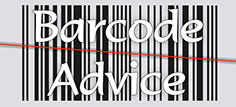
FAQ
- Which barcodes are used in the retail world?
- Where do I obtain my barcode number?
- Can I have my barcode produced at any size I choose?
- What is a light margin or quiet zone?
- What is a digital image?
- Are the printing method and substrate important?
- How do I know my barcode will scan accurately after it has been printed?
- How do I know which colours to use for my barcode?
Which barcodes are used in the retail world?
Virtually all of the barcodes used by retailers worldwide are EAN or UPC symbols. These are standardised by the GS1 system, which has other barcodes for use on outer cases and logistics units, such as pallets. Some retailers, such as Lidl, use a very tall version of these symbols on their own label products, while others such as Ikea, use a different barcode, Code 39.
If you need to barcode your own branded products which will be sold in any shop, you will probably need an EAN barcode, but if you are unsure, then please contact us for help and advice.
Where do I obtain my barcode number?
If you need to use EAN barcodes, you will need to become a member of your national GS1 member organisation. For the UK this is GS1 UK, and their website www.gs1uk.org will provide you with the information you need. GS1’s global website, www.gs1.org, will provide you with information about all the other GS1 member organisations.
If you need barcodes for other sectors, please contact us, and we will be able to let you know whom you need to contact.
Can I have my barcode produced at any size I choose?
There are standards or best practice guidelines with minimum and maximum sizes for the barcodes you can produce. These restrictions ensure that you will be able to print your barcodes accurately so that they can be easily scanned. If you are not sure what this means for you, please get in touch, and we will be able to explain what is possible.
What is a light margin or quiet zone?
Most barcodes require a clear area to the left and right of the bars which must not contain any text or other images. These are now called quiet zones, and were previously known as light margins. Not having wide enough quiet zones is a common reason for barcodes failing to scan.
What is a digital image?
A digital image of a barcode is an electronic file that can be incorporated into artwork design using desktop publishing software such as InDesign or Printworks. The digital image of the barcode is created to be the correct size for the particular artwork for the packaging and the output device being used by your printer, so it should not be re-sized after it has been made.
Are the printing method and substrate important?
Different printing methods and substrates will determine the size of the barcode that can be printed. The different widths of the bars of the barcode must be recognisable by the scanners, which means that barcodes must generally be larger when printed onto poorer quality substrates such as fibreboard. So for example, the size of an EAN barcode when printed onto an egg box is much larger than the one printed on the front cover of a magazine. The colour of the ink used to print the bars and their background colour are also important, as the bars must appear black when scanned by red light. For further advice please contact us.
How do I know my barcode will scan accurately after it has been printed?
There are international standards for printing barcodes, as they need to be readable by different barcode scanners used worldwide. The quality of the final printed barcode can be checked using a barcode verifier which complies with these ISO/IEC and GS1 standards.
There are companies which will verify individual barcode samples for you, and if you need to verify many barcodes on a regular basis, you can buy your own barcode verifier.
How do I know which colours to use for my barcode?
Does my barcode have to be black and white?
While black bars on a white background are a very good combination, your barcode does not have to be black and white. The colour chosen must appear black under red light, so blue and green are possible options. The important thing is to make sure that the colour used for the bars is a pure colour, and not one that is created using a four (or more colour) printing process. You must also make sure that you never reverse-out the image, putting white bars on a black background, because this will not work.
Click here to download a barcode colour code chart in a PDF format.
